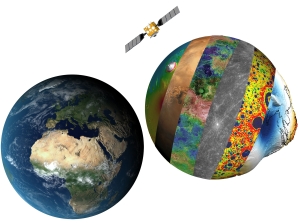Geological evidence of Earth's accretion and earliest evolution is almost non-existent because of volcanic, erosional and plate tectonic processes that have obliterated most of the rock record from the first 500-800 Ma of Earth history. The record of early history is much better preserved on other planets and moons, and a better understanding of the evolutionary history of planets and small bodies in our Solar System therefore directly enhances the understanding of Earth's evolution.
Meteorites, observations, mantle convection and geoid patterns
Early planetary evolution can be tied to radiometric ages from meteorites. Time-scales for planetary surfaces in the inner Solar System are calibrated by linking the lunar cratering rate with the radiometric dates of the lunar samples. Gravity anomalies, topography, magnetic fields and the temporal and spatial distribution of volcanism yield important insights into the internal structure and dynamical evolution of planets. For Earth it is possible to explain the geoid spectrum, even in the absence of seismic tomography, by making simple assumptions about the statistical nature of density heterogeneities, combined with mantle rheology models based on mineral physics. At sufficiently long wavelengths, such models can also explain the geoid spectrum of Mars, Venus and the Moon, and the topography spectrum of Venus, using instantaneous mantle flow models.
CEED aims to study the spatial distribution and time evolution of mantle convection, with emphasis on plumes, in these bodies. For Earth, the geoid pattern is well correlated with the distribution of LLSVPs. A similar geoid pattern, dominated by spherical harmonic degree-2, also applies to Mars, Moon and Mercury. If Mars has antipodal thermochemical piles similar to those above the Earth's core mantle boundary (CMB), volcanism might be expected along the margins of the two geoid highs. Olympus and Alba Montes, two large volcanoes which may have been active for billions of years, and the Elysium volcanic province may represent long-lasting plumes near these margin. Other volcanic centres (e.g. Tharsis Montes) overly the geoid highs. However, a plume-triggering mechanism in terms of slabs (subducted oceanic lithosphere, only on Earth) is not applicable to Mars due to the absence of plate tectonics — Thus a mechanism that explains plumes on the edge of the geoid high without resorting to slab triggering is required unless the plume locations are coincidental.
Aim of theme 4: Earth and Beyond
CEED aims to perform extensive cratering statistics and refine time-frames for planetary evolution. Through modifying models that were initially derived for the Earth, we will explore planetary surface evolution linked to interior processes.
Sub-themes
4.1: Planetary time-scales, Surface ages, Impact cratering and Cratering Statistics
4.2: Crustal Processes and Planetary Evolution

